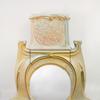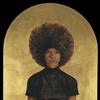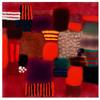Chinese Frescos, Modern Paintings, Seals and Zisha Teapots Lead Gianguan's December 9 Sale.
- NEW YORK, New York
- /
- November 07, 2017
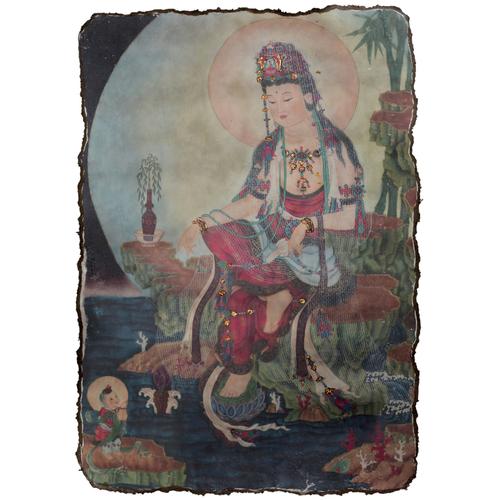
Collectors of revered objects–from Song Dynasty frescos to Yuan ceramics, classic and modern art to signature seals and Zisha teapots–will find strong collections at Gianguan Auctions upcoming sale on Saturday, December 9.
The lead Buddhist work of art is a Song Dynsaty fresco panel depicting the Water-Moon Guanyin, also known as Avalokiteshvara of the Southern Seas. She is portrayed in the traditional posture, seated on rockery, wearing robes and an elaborate headdress with gilt highlights, all backed by a double mandorla. The robes are outlined in thread relief making for an exceptionally detailed portrayal further enhanced by the quality of the remaining mineral pigment that appears to glisten. It is Lot 38, 4' tall, and suitable for a religious institution or a private collector.
Another prized stucco fresco, also of Song origin, is “Court Ladies Tea Banquet” that replicates Zhang Xuan’s famous painting. Ten ladies sip tea from bowls, playing musical instruments and engaging with one another. Reds and green dominate on a clear ground. The 4' long panel has light damage, typical of its age. It is Lot 67. Both works are valued at upwards of $30,000.
Gianguan has gathered an excellent collection of moderately valued modern and contemporary paintings for this sale. Twentieth Century master Xu Beihong (1895-1953), one of the first to reflect a renewed China in his works of animals, is represented by “Two Racing Stallions, 1942, a work that may well be a metaphor to the competitiveness of nations. Signed, with one artist seal, this is Lot 70 valued at upwards of $40,000.
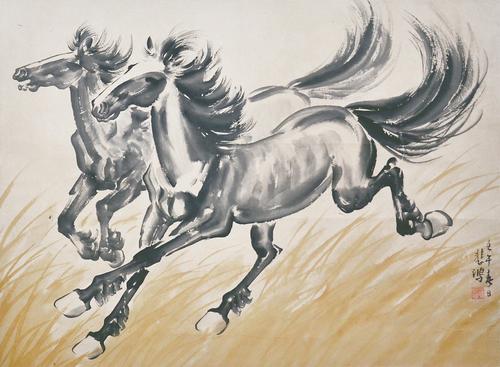
Zhang Daqian's (1899-1983) full length portrait of “Lady Xiang,” the consort of the Forbidden City’s Daoguang Emperor and mother of three of his children is shown as a young woman with flowers in her hair. After her father’s indictment of corruption, she was demoted to “Noble Lady.” She later received the title “Dowager Consort Xiang.” Lot 84 is inscribed and signed Zhang Daqian and has three artist’s seals. It is expected to fetch more than $40,000.
Yu Feian’s “Spring Budding” is the acquisition that offers hope with a realistic portrayal of daffodils, peony and a cawing magpie. Influenced by the realism of Western artists, Yu Feian added a purely historical twist with “slender gold” calligraphy in the manner of Song Emperor Huizong. This is Lot 122, starting at $15,000. An ink-on-paper by Yu Feian was in the collection of Robert Hatfield Ellsworth that sold at Christies in 2016.
It makes a handsome counterpart to the day’s leading ceramic, a masterfully painted 13th C cobalt blue and white bulb vase. The highly detailed interior panorama of a pavilion in landscape make it clear that the manipulation of cobalt blue was already a sophisticated technique when Kublai Khan established his capital on the site of modern Beijing. Lot 105, it is estimated to fetch more than $60,000.
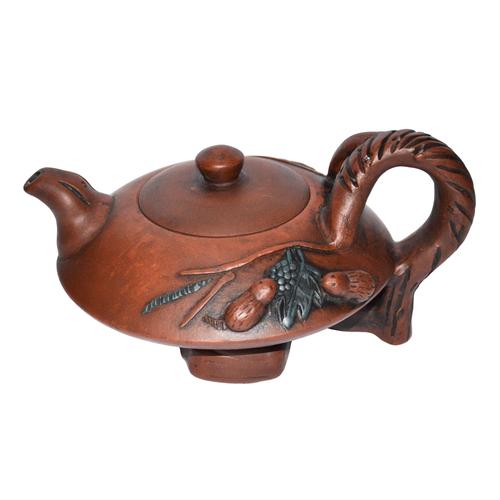
Ceramics reached their apotheosis during the Ming Dynasty, as can be seen in a globular shaped, green glazed brush washer incised with blue florals and lotus petals. The tiny tour de force–4½” in diameter–bears the Xuande six-character mark and is of the period. It is Lot 115, modestly estimated at upwards of $3,000.
The Qing Dynasty advanced a sophisticated coupling of composition and balance that quite likely influenced Art Deco, as seen in Lot 121. The tall powder blue vase is inscribed with cranes and plum blossoms. The expressed angularity and precision detailing make the 18” tall vase a unique collectible. With the Kangxi six-character mark in a double circle seal, and of the period, the vase is valued at more than $10,000.
In 1937, Qi Baishi penned a simple picture of a man fanning the flame of a fire over which he is brewing tea. It is Lot 112, inscribed and signed Qi Huang, with two artists seals, and estimated at more than $80,000. The draftsmanship is superb, of course, but it is his homage to a daily ritual that makes it outstanding. If auctions were staged in vignettes, this painting would lead the collection of Zisha teapots by star potters.
The oldest is Ming master Hui Meng Chen’s compact teapot with applied mountainous landscape and inscription (Lot 261). Perhaps the most conceptual is contemporary Master of Chinese Art Wang Yinxian’s angled pot with slip moulded squirrels that appears to float on its recessed tree-trunk base (Lot 272). Among the Gu Jingzhou teapots is an unusual black basket weave pot with moulded bamboo handle and spout (Lot 285). Most of the teapots are signed and bear artists’ seals. The teapots have catalog estimates of $500-$2,000. It should be noted that the popularity of Zisha teapots has seen several soar recently to as high as 13 times above estimate.
Chinese seals that once again dominate official documents and artwork comprise another popular category in which Gianguan Auctions is the leader. Rare examples include Lot 4, a large Tianhuang stone seal with a fantastical dragon-tortoise knop, 5’ tall, weighing 4 pounds. Lot 23, a pair of crow-skin Shoushan seals with bas relief landscape motifs. Weighing slightly over a pound each, the irregularity in size (4” and 4.5”) is a natural feature. Lot 8 is a minimalistic columnar seal of red Ji Xue (chicken blood stone) with white inclusions. Estimates on the seals run from $500-$2,000.
No Chinese art auction would be complete without carved jades. The category’s marquee item is an 1,800-year old white, translucent jade stem cup of the Qin Dynasty. Exceedingly rare, it is has a U-shaped body finely carved with C-shaped scrolls between two bands of archaic symbols. The looped handle has a flange flourish. The cup is similar to one displayed in the Metropolitan Museum of Art’s 2017 exhibition “Age of Empires, Chinese Art of the Qin and Han Dynasties.” Lot 102 bears a catalog value of more than $20,000.
Several Warring States (5th c. BC) bronze spears attest to the upheavals in power that led to the founding of the Qin Dynasty. Lot 47 is a handsome curved ritual blade with Leiwen inscriptions and slits for attachment. Malachite encrustations authenticate age. Lot 48 is a tapered blade with median ridges decorated with geometrics and taotie masks, also with malachite encrustations. Lot 49 is a rare bronze sword with beveled edges that taper to a point, and decoration at the pommel. Bidding on these items begins at $2,000.
Meanwhile, from the same period comes a highly-polished turquoise bi with a comma form frieze surrounded by a register of dragons and phoenix scrolls. The 7” wide ritual disk is Lot 81, expected to bring more than $2,000.
For details on all the fine consignments in Gianguan Auctions upcoming December 9 sale, please view the catalog at www.gianguanauctions.com. The properties are also on liveauctioneers.com and invaluable.com.

270x400_c.jpg)



